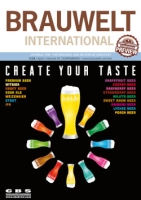… but has his knowledge outlived its usefulness? In the age of the Internet and smart phones, the programmes and apps all about beer brewing that can be downloaded from the Internet never cease to amaze one. Complete recipe calculations are possible and with smidgens of basic knowledge, the final alcohol content of a beer can be calculated more or less accurate to within a tenth.
Symrise AG is strengthening its product offering for natural beverage applications and further expands into the strongly growing market of flavored water: The Company signed an agreement to acquire Flavor Infusion, a highly specialized supplier for natural beverage solutions in North America, from its founders. With this investment, Symrise is gaining immediate access to the company’s profound knowledge as well as already marketed products and its most reputable customer base.
Gea has launched a new group structure developed as part of its “Fit for 2020” initiative. With immediate effect, the Group is bundling and reporting the development and manufacturing of products and the provision of process solutions in two new business areas – “Equipment” and “Solutions”.
The Brewers of Europe’s announcement of a major commitment to list ingredients and nutrition information for beer at the end of March drew mixed reactions.
In the previous article (BRAUWELT International no. 1, 2015, pp. 20-22), a possibility of calculating alcohol content (% w/w) of finished beer based on the two parameters “original gravity before fermentation” and “apparent extract” was described. In most instances however, small breweries and craft brewers test their finished beer purely by sensory analysis in the absence of in-situ, expensive equipment. In this article, I would like to give small breweries means for preparing an “abridged beer analysis” in-house, based on calculations generally widespread in the brewing sector.
With total output of 6.4 million hl per year Krombacher Brewery, founded in 1803, is one of the largest private breweries in Germany. The company’s success: the high quality of their products. Taste, turbidity and shelf life of the beer play an important role in this process – for all these factors the dissolved oxygen content of the product is key. Based on this background, continuous measurement of the dissolved oxygen content is very important – and the sensors of the Swiss company Hamilton Bonaduz AG provide a significant contribution.
Mödinger, M.; Landerer, K.: Sustainability in Craft Brewing, 2014, 104 pages, soft cover, Fachverlag Hans Carl GmbH, Nuremberg, 19.90 EUR.
Euromalt, the European malting industry Association, and the European Brewery Convention (EBC), the technical and scientific arm within The Brewers of Europe, have reached an important breakthrough in the research on gushing: in a joint research project with the German Research and Teaching Institute for Brewing in Berlin (VLB), a potential method to predict the gushing potential of malt and beer samples was identified.
Continuous improvement | For many years beverage production plants had the goal of reducing consumption and increasing productivity. Both financial and climate protection aspects have been keeping continuous improvement processes alive. This article looks at the implications these optimization efforts have on users’ demands for energy data management systems (EDMS).

